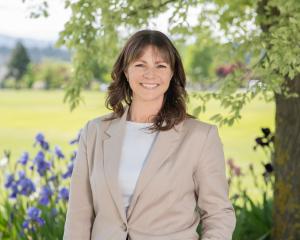
She initially thought it was spam, and took ''quite a bit of convincing'' to realise it was real.
But there in Annemarie Hope-Cross' inbox was an email telling of an ''honourable mention'' for her entry in the international Julia Margaret Cameron Awards.
Three of her photographic images had been recognised and will now appear in a ''Women Photographers Today'' exhibition being held as part of the world-famous ''Foto Bienniale'' fine art and documentary photography exhibition in Barcelona in May.

The winning images come from a body of work created during a year of battle and turmoil, when Hope-Cross was thrown a health curveball that forced a new take on practically everything - breast cancer.
Hope-Cross has looked it square in the eye and wants to tell people ''the positive stories of breast cancer'', of ploughing through, taking on challenge and accepting the changes cancer can bring.
For Hope-Cross, one of those changes was being forced to slow down, and her photographic artworks over the past year have reflected that.

''If I hadn't had the time to slow down, and do a lot of thinking, I wouldn't have had the time to do these images.''
She has found ''healing and wellbeing in the stillness'', and valued the opportunity for contemplation.
''Many memories have come to mind, often sparked by precious objects such as bottles of photographic chemicals from my grandfather, or a bottle of perfume my father gave my mother. Bottles are receptacles for many things: healing herbs and medicines, darkroom chemicals, perfumes, nourishing creams, foods and wine. To me they speak of memories, and are perhaps allegories for life itself.''

''In the early hours of the morning after I was advised of the [breast cancer] diagnosis, I remembered the Apotheken Museum, which I had visited in 2002, and reflected on how healing can come through many forms. Over the many, many hours I have not been well enough to make images, I have lain on the bed and thought about the images I want to make as part of this project; I've done research and made preparations for the works. It has definitely been good for my soul and helped sustain me through some rougher times, having positive things to think about - the desire to be well and make this project, and to make it into old age with [husband] Eric [Schusser].''

Her ''Still'' and ''Heidelberg'' images are made using a mousetrap camera in her garden, using a 180-year-old technique. Each exposure required up to eight hours in the sunshine.
Last year some of her photogenic drawing images featured in an international exhibition at the Fox Talbot Museum in England. Fox Talbot is known as the ''English father of photography'' and created the world's largest collection of photogenic drawings.
Hope-Cross has been twice to his home in Wiltshire, Lacock Abbey, once assisted by an Alexandra Community Arts Council scholarship, and then as an invited artist in residence.
Because she was dealing with her cancer at the time, she was unable to attend the Fox Talbot exhibition ''Photography in its Birthplace'', in which Hope-Cross was one of just five featured photographic artists.
But she now feels able to start planning more overseas trips, encouraged by hearing positive stories about breast cancer.
''When I told the [Fox Talbot exhibition] curator why I couldn't be at the exhibition opening, he told me his mum had had breast cancer, and 35 years later is still doing fine.
''This lady, who I have never met, has become my inspiration to make it to 84 years of age, adding on 35 years from when I was diagnosed, aged 49,'' Hope-Cross said.
''My message is this: One out of nine women in New Zealand gets this disease. There should not be a stigma surrounding it; we didn't ask for this and it's nothing to be ashamed of. I've also been amazed how many (often young) women I have since heard of who've had breast cancer; we can support each other if we talk.
''Be vigilant - it [breast cancer] may not be a pea (mine was a ridge, at 12 o'clock towards the chest wall) and it may not show on a mammogram (mine didn't, twice).
''I am going to beat this thing, and be the better for it. Already I've enjoyed a tiny bit of cross-country skiing, and the photography continues.''
Annemarie Hope-Cross
- Photographic artist Annemarie Hope-Cross uses early pioneering photography techniques, some of which are referred to as camera-less photography and hark back to the dawn of photography when light-sensitive silver and other chemicals were coated on to paper before a leaf or something similar was put on to the paper and then put out into the sun to form a chemical reaction. The result is like an X-ray.
- For the ‘‘Still’’ and ‘‘The Heidelberg Project’’ images Hope-Cross is working on at present, she is using a mousetrap camera in her garden and a 180-year-old technique. Each exposure requires up to eight hours in the sunshine.
- The international Margaret Cameron Awards in which some of Hope-Cross’ ‘‘Still’’ images have received an honourable mention are named after Julia Margaret Cameron (1815-79), who was given a camera aged 48 and mastered the difficult wet plate collodion process Hope-Cross also uses.
- Hope-Cross’ work has also been recognised in the English birthplace of Fox Talbot (1800-77), who is considered one of the founders of photographic processes and invented several photographic techniques. Talbot created the world’s largest collection of photogenic drawings. The term photogenic drawing refers to the salt and silver coated on to paper, which can then be used in a camera, or to make contact prints without using a camera. Hope-Cross has created the world’s second largest collection of photogenic drawings.
- Three of Hope-Cross’ ‘‘Still’’ images will be displayed in the ‘‘Women Photographers Today’’ exhibition being held as part of the world-famous ‘‘Foto Bienniale’’ fine art and documentary photography exhibition in Barcelona from May 8-29.









